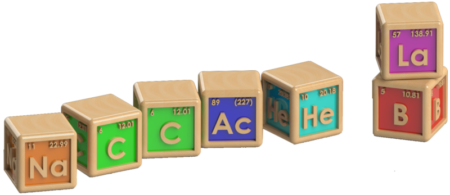Our research program is concerned with the study of the fundamental properties of fluorescent carbon dots
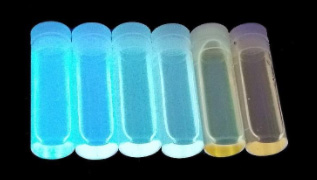
leveraging the knowledge gained to engineer nanomaterials and nanoconstructs that can be integrated in sensing, imaging and catalysis applications.
Carbon dots are a relatively new class of nanomaterials and are particularly interesting as they can be prepared from an abundance of sources and are regarded as having low chemical toxicity and high biocompatibility. They can be excited using multiple wavelengths ranging from ultraviolet to near-infrared with highly tunable emissions in the same range of wavelengths. Our research aims to investigate multiple avenues in the synthesis of carbon dots in order to devise methods of preparing highly monodisperse particles with narrow size distributions and specific optical signatures.
Carbon Dots for Imaging and Sensing
Due to their tunable optical properties, low cytotoxicity and good biocompatibility, carbon dots are highly suitable for bioimaging. One of our interests lies in the development of a bimodal imaging probe that can be used for both fluorescence and magnetic resonance imaging. Both of these techniques possess their individual merits and can be viewed as complementary diagnostic tools. In order to endow magnetic properties, paramagnetic gadolinium ions are doped into the dots. In addition, their fluorescent properties allow for sensing environmental changes such as temperature and pH, which can provide additional insights in a diagnostics setting. Each sensing modality is based on changes to the fluorescence signature. We have recently made significant strides in the development of dual fluorescent carbon dots that can simultaneously emit in multiple regions of the spectrum following excitation. We exploit these dual-fluorescent dots to sense both pH and temperature in complex biological systems. Such a ratiometric approach is superior to intensity-based measurements due to its concentration-independence. Results have shown that these CDs can be effective nanotools to glean information at the cellular level.

Carbon Dots as Heterogeneous Catalysts
Global energy demands will grow to staggering numbers in the near years to come and will continue to increase as fossil fuel dependency continues to rise. This has accelerated the search to find alternative energy sources to replace conventional fossil fuels with biofuels, such as biodiesel. Presently, biodiesel is produced through the transesterification of vegetable oil using an alcohol, most commonly methanol, and a strong base such as potassium hydroxide. Although this method achieves high biodiesel conversion yields many challenges persist such as high production costs due to tedious purification processes and the inability to recover and reuse the catalyst ultimately leading to unsustainable practices. To address these drawbacks, carbon dots can be exploited as heterogenous nanocatalysts to efficiently catalyze the transesterification reaction. Our carbon dot systems are derived from cheap and easily accessible precursors such as citric acid and glycine. Using carbon dots as heterogenous transesterification catalysts can permit biodiesel production to become a more environmentally-friendly, cost-efficient and sustainable process that can meet future energy demands.
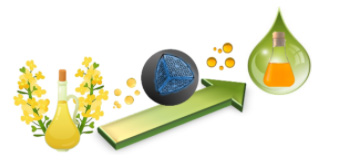
Hybrid Nanomaterials
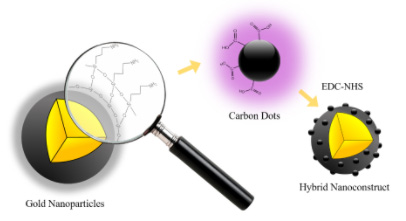
We design hybrid nanomaterials which combine plasmonic nanoparticles including gold with carbon dots.
Exploiting the synergy between the plasmon resonance of the gold and
the fluorescence of the carbon dots, a platform with unique optical properties can be formed. We focus on the study of the effects of the size and morphology of gold nanoparticles, over a wide surface plasmon resonance range, on the optical properties of the dots. Our work has shown an enhancement of the optical properties of the carbon dots where specific fluorescence states are favored to the detriment of others. These findings suggest that hybrid materials can be used to both enhance and modulate the optical properties of carbon dots.
Carbon dots in Metal Sensing Applications
Overexposure to metals can induce adverse health and environmental effects, thus monitoring metal concentrations is crucial. While current detection techniques are highly sensitive, they come at elevated costs, which limit their 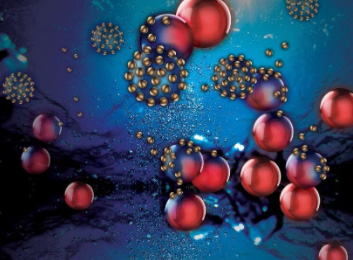 global use. As such, cheap and accessible sensors, providing both sensitivity and selectivity, are in high demand. We aim to develop carbon dot sensors to selectivity detect heavy metal cations in water. We exploit carbon dot fluorescence to design these optical probes. Upon contact with metal ions in water, the fluorescence of the carbon dots is quenched. The change in their fluorescence intensity as a function of metal concentration can be used to quantitate metal ions in a solution. Although CDs have been extensively studied in this area, there remains a lack of understanding when it comes to the fundamental chemistry and mechanism of the metal-CD interactions. A better understanding of how these sensing systems work can also provide researchers with the tools necessary to design more sensitive and selective metal detecting NPs that can translate to concrete applications.
global use. As such, cheap and accessible sensors, providing both sensitivity and selectivity, are in high demand. We aim to develop carbon dot sensors to selectivity detect heavy metal cations in water. We exploit carbon dot fluorescence to design these optical probes. Upon contact with metal ions in water, the fluorescence of the carbon dots is quenched. The change in their fluorescence intensity as a function of metal concentration can be used to quantitate metal ions in a solution. Although CDs have been extensively studied in this area, there remains a lack of understanding when it comes to the fundamental chemistry and mechanism of the metal-CD interactions. A better understanding of how these sensing systems work can also provide researchers with the tools necessary to design more sensitive and selective metal detecting NPs that can translate to concrete applications.
Carbon Dots as Anti-Microbials
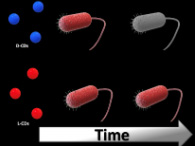
We explore the microwave-assisted synthesis of chiral carbon dots generated from chiral amino acid precursors. This allows us to develop chiral specific anti-viral and anti-microbial applications. We study the underlying effects of the synthesis parameters on the chirality of carbon dots, as well as the impact on their optical signature. Chiral dots evidence different behaviour towards various bacterial strains, which is promising in the development of smart surfaces. Our work has intensified in this area and a strong focus has been placed on the mechanistic aspects of the carbon dot-pathogen interactions.
